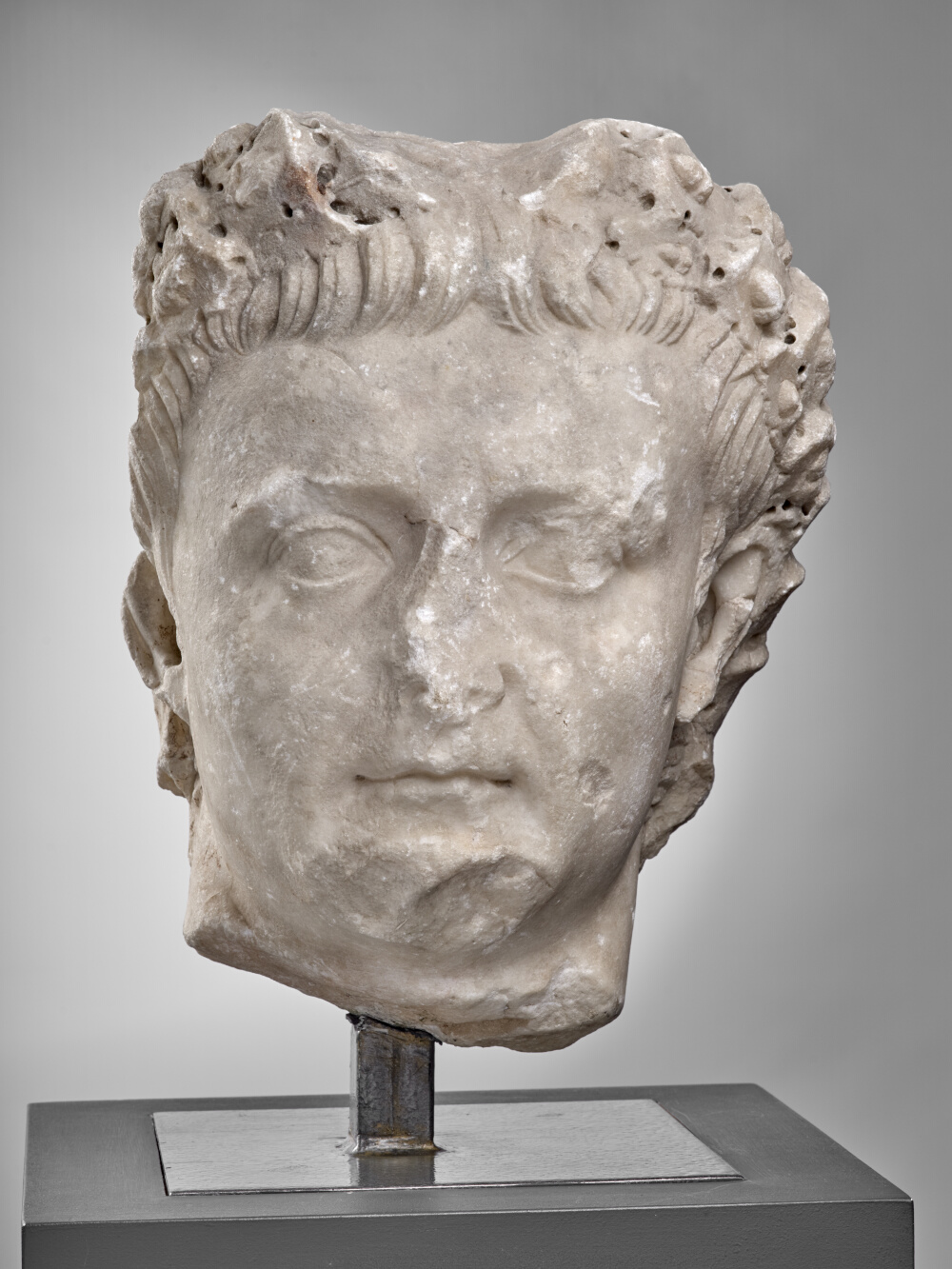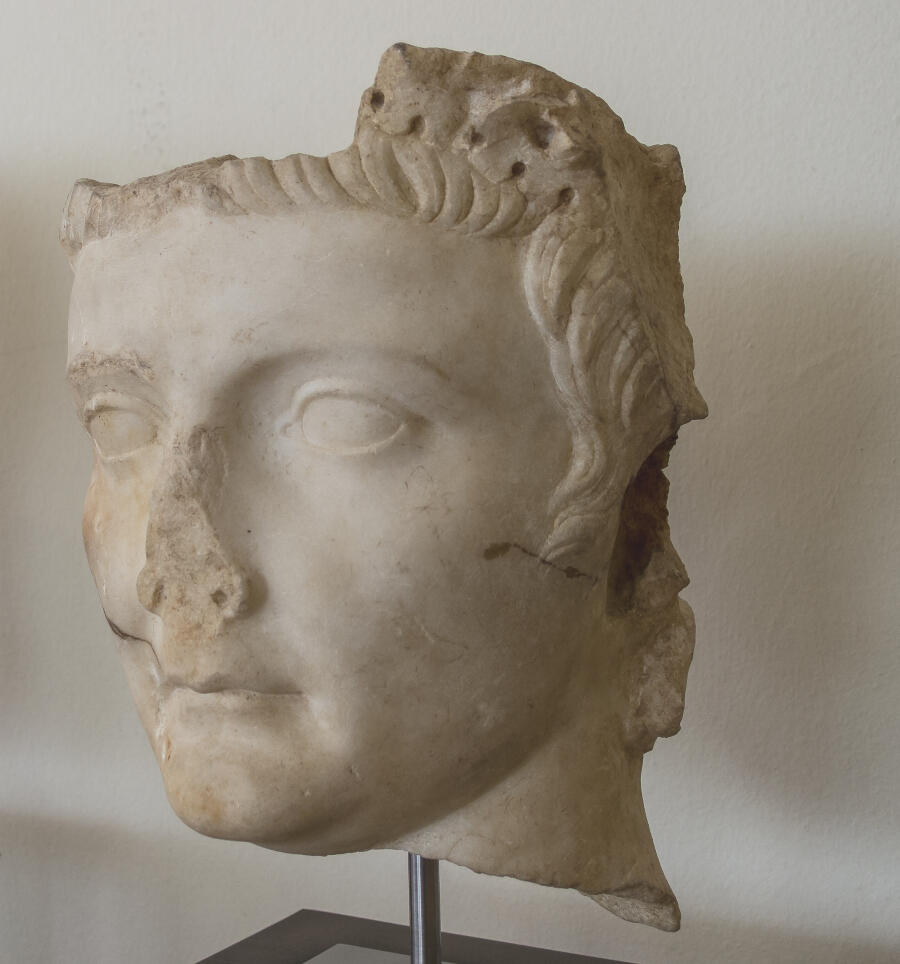Head of Tiberius wearing a crown of oak leaves








- Biographic data
- 42 – 37 BC
Emperor from 14 to 37 - Date de création
- Last decade of reign (AD 26/27-31)?
- Type
- A reversed version (fringe strands) of the "Berlin-Naples-Sorrente" type
- Material
- Lychnites marble (island of Paros)
- Dimensions
- H. 34 x l. 18 x P. 22,2 (cm)
- Inventory number
- Ra 90
- Photo credits
- Daniel Martin
First mentioned in a catalogue published in 1912, where it was associated with the works unearthed during the Chiragan excavations in 1826 and 1828, this head has not been referred to in any other source. Léon Joulin himself did not mention it, nor did he draw it in his work published in 1901. As a result, and pending a conclusive testimony, one can only remain cautious when it comes to linking this portrait of Tiberius to the villa.
Born in 42 BC, to Livia and Tiberius Claudius Nero, Tiberius belongs to the gens Claudia, a family of prestigious lineage. He was three years old when his mother remarried, taking for husband Octavian, Julius Caesar’s heir and member of the Second Triumvirate alongside Mark Antony and Marcus Aemilius Lepidus. Following the deaths of all his presumptive heirs, Octavian, who now bore the name of Augustus, was forced to adopt Livia’s son, thus associating the name of the Claudii with the people of the Julii.
The characteristics chosen to describe this heir, who ascended the throne at the age of 55, seem to be diametrically opposed, both psychologically and politically, to those of his stepfather. Indeed, the portraits remain dominated by an uncompromising and objective description far removed from the Greek ideals of his stepfather’s representations. However, the arrangement of fringe strands, borrowed from the Augustus of Prima Porta type, betrays his need to appropriate certain details from the images inherent to the previous reign, proof of the sovereign’s loyalty to this regime, and an expression of dynastic longevity. The Toulouse head is highly original in this sense: while the strands of hair are identical to those of the main portraits of the « Berlin-Naples-Sorrente » type, they have nevertheless been reversed, and this is something for which we have no real explanation.
It is well known that this character had a complex personality. Fleeing the venomous atmosphere of the capital in AD 27, he went into exile on the island of Capri, where he remained until his death. Chiragan’s head is based on a prototype that was created very late; Tiberius was between 65 and 75 years old at the time, and had therefore not lived in Rome for a long time. Yet he had never before been depicted wearing a chaplet of oak leaves. The prince is said to have refused to hang this mark of distinction in the entrance court of his palace. This emblem, which evokes the emperor’s clemency, and equates him with Jupiter, is also associated with the title of « Father of the Fatherland » (Pater Patriae), an honour challenged by Tiberius himself Tacite, Annales, 1st century, 2, 87 ; Suétone, « Tibère, » Vies des douze Césars, beginning of the 2nd century, 26,4 et 67,2 ; D. Cassius, Histoire romaine, 2nd century, 57, 8, 1..
Part of the crown on the head of the statue in the Musée Saint-Raymond was probably broken from the outset, maybe during the carving of the oak leaves, which is a very delicate operation for the sculptor. This explains the large mortise, located on the right-hand side, which corresponds to a repair and the insertion of a prosthesis. A similar accident explains the hollowed-out  portrait of the emperor discovered in Tarragona E.M. Koppel, « Retratos de Tiberio y de Nero Caesar en Tarragona, » P. León Alonso, T. Nogales Basarrate, Reunión sobre escultura romana en Hispania (eds.), Actas de la III reunión sobre escultura romana en Hispania, Cordoue, 1997, Madrid, 2000, pp. 81–91, pp. 81-83..
portrait of the emperor discovered in Tarragona E.M. Koppel, « Retratos de Tiberio y de Nero Caesar en Tarragona, » P. León Alonso, T. Nogales Basarrate, Reunión sobre escultura romana en Hispania (eds.), Actas de la III reunión sobre escultura romana en Hispania, Cordoue, 1997, Madrid, 2000, pp. 81–91, pp. 81-83..
According to J.-C. Balty 2005, Les portraits romains, 1 : Époque julio-claudienne, 1.1 (Sculptures antiques de Chiragan (Martres-Tolosane), Toulouse, p. 163-179.
Bibliography
- Balty, Cazes 2005 J.-C. Balty, D. Cazes, Les portraits romains, 1 : Époque julio-claudienne, 1.1 (Sculptures antiques de Chiragan (Martres-Tolosane), Toulouse. p. 164-179, no 6
- Cazes et al. 1999 D. Cazes, E. Ugaglia, V. Geneviève, L. Mouysset, J.-C. Arramond, Q. Cazes, Le Musée Saint-Raymond : musée des Antiques de Toulouse, Toulouse-Paris. p. 118, fig. 120
- Espérandieu 1908 É. Espérandieu, Recueil général des bas-reliefs de la Gaule romaine, 2. Aquitaine, Paris. p. 95-96, no 1012
- Felletti Maj 1959 B.M. Felletti Maj, « Claudio. »p. 706
- Fittschen, Zanker 1985 K. Fittschen, P. Zanker, Katalog der römischen Porträts in den Capitolinischen Museen und den anderen kommunalen Sammlungen der Stadt Rom, Mainz. p. 15, no 13
- Gascou, Terrer 1996 J. Gascou, D. Terrer, « La présence de Tibère en Narbonnaise : les portraits et les inscriptions, » Revue archéologique de Narbonnaise, 29, 1, pp. 31–67. p. 47-49, fig. 28-30
- Hausmann 1985 U. Hausmann, « Bemerkungen zum " dritten’ Portrat- Typus des Tiberius, » Quaderni ticinesi, 14, pp. 211–225. p. 222 exemplaire "u"
- Hausmann 1988 U. Hausmann, « ‘Redeat Narratio’ : zu einem Kaiserporträt in Ancona, » Ritratto ufficiale e ritratto privato, Rome, pp. 331–334. p. 332 exemplaire "q"
- Koppel 2000 E.M. Koppel, « Retratos de Tiberio y de Nero Caesar en Tarragona, » P. León Alonso, T. Nogales Basarrate, Reunión sobre escultura romana en Hispania (eds.), Actas de la III reunión sobre escultura romana en Hispania, Cordoue, 1997, Madrid, pp. 81–91.
- Rachou 1912 H. Rachou, Catalogue des collections de sculpture et d’épigraphie du musée de Toulouse, Toulouse. p. 53, no 90
- Rosso 2006 E. Rosso, L’image de l’empereur en Gaule romaine : portraits et inscriptions (Archéologie et histoire de l’art), Paris. p. 443-445, no 211
- Salviat, Terrer 1980 F. Salviat, D. Terrer, « À la découverte des empereurs romains et de leur famille, à travers les historiens et les portraits de Gaule Narbonnaise, » Les dossiers de l’archéologie, 41, pp. 6–87. p. 28, 30, fig. p. 27
- Terrer, Lauxerois, Robert 2003 D. Terrer, R. Lauxerois, R. Robert, Nouvel Espérandieu : recueil général des sculptures sur pierre de la Gaule. Tome I : Vienne (Isère), Paris. p. 72 (à propos du no 143)
- Centro de Exposiciones Arte Canal 2007 Centro de Exposiciones Arte Canal, Roma S.P.Q.R : Senatus Populus Que Romanus. Exhibition Centro de Exposiciones Arte Canal, Madrid, 20 november 2007 - 2 march 2008, Madrid. p. 100-101, no 21
To cite this notice
Capus P., "Head of Tiberius wearing a crown of oak leaves", in The sculptures of the roman villa of Chiragan, Toulouse, 2019, online <https://villachiragan.saintraymond.toulouse.fr/en/ark:/87276/a_ra_90>.